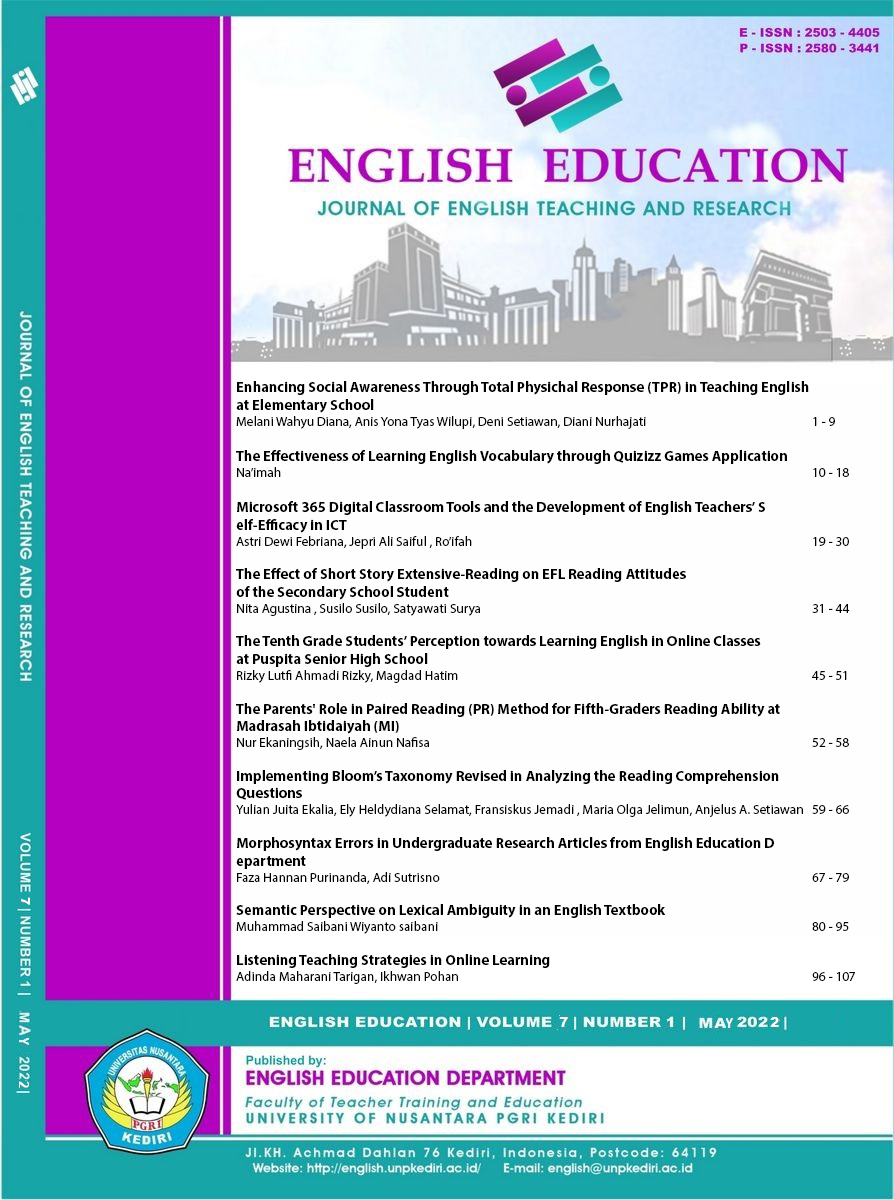Implementing Bloom’s Revised Taxonomy in Analyzing the Reading Comprehension Questions
DOI:
https://doi.org/10.29407/jetar.v7i1.17823Keywords:
Reading comprehendsion, Questions, Bloom's TaxonomyAbstract
Bloom's revised taxonomy is the most frequently utilized as an instrument for objective-as a basis for assessment and as a representation for producing objects that evaluate processes ranging from memorization to more complex cognitive levels such as knowledge assessment. It is predicted that the mix of cognitive levels in the 2013 curriculum will drive students to think critically, to think creatively, to be problem solvers, and have a decision maker competencies. Using teaching resources such as textbooks as one of the learning media to train students' critical thinking. The goal of this research is to figure out the cognitive levels in the revised Blooms' Taxonomy utilized in The Ministry of Education and Culture's (MOEC) textbook "Bahasa Inggris SMA/MA/SMK,MAK grade X." The qualitative approach and content analysis were used in this study's research design. This study analyzed the proportion of the lower-order thinking (LOT) and the higher-order thinking skills (HOTS) questions based on the cognitive levels Bloom’s taxonomy. The researcher compiled a list of the reading comprehension questions and counted degree of cognition in each book chapter. According to the findings, there are 114 reading comprehension questions. Lower order thinking (LOT) is the most prominent level in this book. Lower-order thinking skills (LOTS) account for 69 percent of the total, whereas higher-order thinking skills (HOTS) account for only 8%. It was suggested that the material of the textbook be expanded upon, with a greater emphasis on Higher Order Thinking Questions.
Keywords:Reading Comprehension, Questions, Bloom’s Taxonomy
Downloads
References
Abdelrahman, M. (2014). “An analysis of the tenth grade English language textbooks questions in Jordan based on the revised edition of Bloom’s taxonomy,” J. Educ. Pract., vol. 5, no. 18, pp. 139–151.
Armstrong, P. (2016). “Bloom’s taxonomy,” Vanderbilt Univ. Cent. Teach.
Assaly, I. & Igbaria, A., K. (2014). “A content analysis of the reading and listening activities in the EFL textbook of master class,” Educ. J., vol. 3, no. 2, 24–38.
Atiullah, K., Fitriati, S. W., & Rukmini, D. (2019). “Using revised Bloom’s taxonomy to evaluate higher order thinking skills (HOTS) in reading comprehension questions of English textbook for year X of high school,” English Educ. J., vol. 9, no. 4, 428–436.
Aziz, E., N. & Yusanti, G. (2020). “Increasing Students’Reading Comprehension Skill by Using Written Text Book ,” English Educ. J. English Teach. Res., vol. 5, no. 2, pp. 179–186.
Borich, D. G. (2016). Observation skills for effective teaching: research-based practice. Routledge.
Drisko, J. W. & Maschi, T. (2016). “Content analysis,” Pocket Guides to Social Work R.
Febrina, F., Usman, B., & Muslem, A. (2019). “Analysis of Reading Comprehension Questions by Using Revised Bloom’s Taxonomy on Higher Order Thinking Skill (HOTS),” English Educ. J., vol. 10, no. 1, 1–15
Forehand, M. (2010). “Bloom’s taxonomy,” Emerg. Perspect. Learn. teaching, Technol., vol. 41, no. 4, 47–56.
Koss, M., D. (2015). “Diversity in contemporary picturebooks: A content analysis,” J. Child. Lit., vol. 41, no. 1, 32,
Manarin, M. K., Carey, M., Rathburn, & Ryland, G. (2015). Understanding Children’s Reading Activities: Critical reading in higher education: Academic goals and social engagement. Indiana University Press.
Panggabean, C. I. T. & Asariski, A. (2021). “An Analysis of EFL students’ questions in Research on ELT class at University of PGRI Ronggolawe Tuban,” English Educ. J. English Teach. Res., vol. 6, no. 1, 13–21.
Shara, O., L. (2021). “Reading comprehension questions analysis of English textbook ‘Forward of English’ based on cognitive domain of revised Bloom’s Taxonomy.”
Downloads
Published
Issue
Section
License
Authors who publish with this journal agree to the following terms:
- Copyright on any article is retained by the author(s).
- The author grants the journal, the right of first publication with the work simultaneously licensed under a Creative Commons Attribution License that allows others to share the work with an acknowledgment of the work’s authorship and initial publication in this journal.
- Authors are able to enter into separate, additional contractual arrangements for the non-exclusive distribution of the journal’s published version of the work (e.g., post it to an institutional repository or publish it in a book), with an acknowledgment of its initial publication in this journal.
- Authors are permitted and encouraged to post their work online (e.g., in institutional repositories or on their website) prior to and during the submission process, as it can lead to productive exchanges, as well as earlier and greater citation of published work.
- The article and any associated published material is distributed under the Creative Commons Attribution-ShareAlike 4.0 International License








 Article template
Article template



